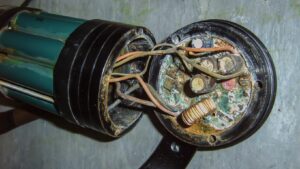Ever found yourself staring at a prized electronic device, only to discover it’s been ambushed by the dreaded enemy – corrosion? It’s a common issue that can drastically reduce the lifespan of your gadgets, but don’t despair. With the right knowledge, it’s possible to wage a successful war game against this unwelcome intruder.
How to Remove Corrosion from Electronics

The restoration of electronics begins with an assessment. Readers, identify the affected areas and if corrosion is widespread, professional help can be a more reliable option.
If limited to minor spots, proceed with home strategies. Carefully unplug and disassemble the device, setting aside each part safely. Wear gloves for protection and use a soft brush to gently remove noticeable corrosion.
Wiping down areas with a cotton swab dipped in isopropyl alcohol showcases its corrosion-dissolving capabilities. Allow it to sit for a few moments before proceeding.
Finally, dabbing affected parts with white vinegar, a rust removal agent, provides an extra layer of cleansing. Once treated, dry the components thoroughly before reassembling.
This guide prescribes a routine to follow, yet caution before action is a significant aspect of the process. One needs to assess whether home-remedies are apt or if professional consultation claims precedence. Patience and precision, in this scenario, bring back the sheen of your devices, protecting it from further casualty.
Tools and Materials Needed for Corrosion Removal

In the process of removing corrosion from electronics, certain tools and materials prove indispensable. A soft brush efficiently sweeps away loose corrosion bits, offering a clean start. Isopropyl alcohol acts as a potent cleaning solvent, dissolving corrosion without hurting the electronic components. Additionally, some instances might call for the milder white vinegar.
Cotton swabs or microfiber cloth serve the dual purpose of applying the solvent and absorbing loosened corrosion. Complexity of the task might necessitate using a set of precision screwdrivers for disassembling the electronics. Lastly, having a blow dryer on standby ensures quick, thorough drying after the cleaning.
Thus, it’s recommended to gather all these tools and materials before undertaking corrosion removal, providing ease and efficiency. As always, application of these tools must follow safety precautions, as handling electronics poses risks, including potential short circuits if not dealt with meticulously.
How Does Corrosion Affect Electronics?
Corrosion impacts electronics by introducing chemical alterations to the constituent materials, particularly the metal contacts and pathways. In severe forms, corrosion manifests as visible rust or greenish oxidation on the electronic circuitry, if left unchecked, it’s a prime cause of device failure. These empirical changes, coupled with the inevitable breakdown of the device’s functionality, form the basis of corrosion’s harmful effects.

A hallmark effect is impedance—the opposition to the flow of electricity within a circuit. Corrosion increases impedance, slowing the efficient transfer of data and power. When corrosion affects insulators—the components designed to prevent electrical current flow—the result is a short-circuit, leading to component or total device failure.
Here’s a simple analogy: think of corrosion as road conditions. Like how potholes and debris slow driving, corrosion impedes the metaphorical “fleet” of electricity that must pass through. Electronics need smooth, clear paths for optimal function—corroded paths cause traffic jams, slowdowns, or complete blockages.
Decoding how corrosion affects electronics unveils the urgency of swift action when signs of corrosion appear on any device.
Common Causes of Corrosion in Electronics
Understanding the common causes of corrosion in electronics is crucial to prevention. It’s the first step in safeguarding gadgets from this silent destroyer. The guide’s focus on careful disassembly and cleaning with isopropyl alcohol and white vinegar shows that it’s possible to manage minor corrosion at home. However, for severe cases, the need for professional assistance can’t be overstated.
Corrosion is a serious threat to electronics. It requires immediate attention and respect to maintain optimal functionality. With the right knowledge and tools, it’s possible to keep your electronics corrosion-free and in top-notch condition.

